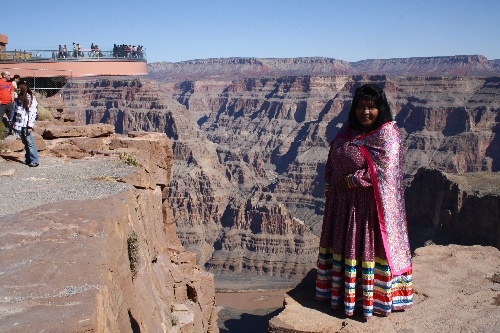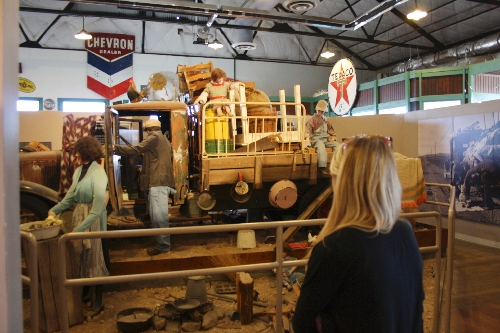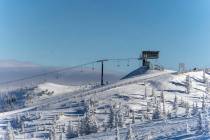Arizona’s Perfect Jumping-Off Place
CERCA CONTRIBUTOR
As a frequent traveler to Arizona, I go by way of Kingman on most of those journeys. In the past, I usually breezed through, immediately hopping on the interstate with barely a passing glance. Earlier this month, though, I decided to make Kingman my primary destination, turning my full attention to what makes this city different.
I learned it has been a good place for travelers to stop for centuries. Indian travelers rested at nearby Beale Springs, as did weary soldiers marching an early military highway. The town grew up along a railroad that became the famed Atchison, Topeka & Santa Fe, and superior food at its meal stops, including Kingman, was one reason for its fame. Today, this is where east-west-bound Interstate 40 and historic Route 66 cross the north-south U.S. 93.
Besides timely chow and historic attractions in town, Kingman offers a gateway to driving the longest continuous stretch of Route 66 in the United States, visiting the old mining towns of Oatman and Chloride, and the unique experience of treading the Skywalk at Grand Canyon West on the Hualapai reservation.
My visit started directly on Route 66 in Kingman's historic district. Here, we found not only the area's main visitor center, but two fine museums and dozens of historic homes and buildings.
The Kingman Powerhouse Visitor Center is the place to get maps, brochures and general information on visiting northwestern Arizona. About 100 years ago, this two-story was one of the largest steam generating plants in the west.
Housed inside is the Historic Route 66 Museum, which uses memorabilia, photos and dioramas to tell the "Mother Road" story from pioneer times through the 1950s. A life-size diorama of a family of Dust Bowl refugees, camping along the road to California, will probably evoke your pity. Another, of a better-off family in a mint-condition 1950 Studebaker, will stir nostalgia for days when the auto was king and Route 66 the king's highway west.
Just a couple of minutes' walk down the street is the Mohave Museum of History and Arts. Since ranching, the railroad and American Indians all played important roles in shaping the character of Northwestern Arizona, the majority of the exhibits reflect this.
Roy Purcell, now famous as an artist, was the museum's director in the 1960s and is responsible for many of the murals and dioramas. I especially enjoyed a full-sized wickiup dwelling he constructed in the Hualapai Indian room. Also on display are many Indian artifacts, including pottery and baskets; one Hohokam piece dates from around the third century.
Outdoor exhibits showcase ranching, mining and the railroad. There is a car first built in 1893 to haul cattle, than reconfigured in 1923 as a caboose for crews of the Santa Fe. I went inside and found it quite charming, with built-in wooden storage compartments, plenty of seating and homey red-checked curtains.
Kingman's most famous son, Andy Devine, is remembered with a fine collection of memorabilia donated by his family. In more than 400 films, Devine was most recognizable for his raspy voice, thought to result from a freak childhood accident, and for his eventually stout figure. He was rarely the leading man, but beloved as Wild Bill Hickock's sidekick "Jingles" and a brave Tennessee volunteer in "The Alamo." The Devine family moved to Kingman when he was a year old, after his father purchased the Hotel Beale, a stopping point for travelers on the Santa Fe. Once rather elegant, the building currently is being renovated.
From the museum, I continued on foot to visit some of more than 60 homes and buildings listed on the National Registry of Historic Places. One highlight was the Little Red School House, a brick building opened in 1896, which now serves as the city court. Another was the two-story Bonelli House, constructed in 1915 for a prominent family of merchants and ranchers. Considered quite a mansion in its time and place, it's a good example of Anglo-Territorial architecture. It was adapted to the hot climate with thick walls made of locally quarried tufa stone, French doors and tall windows for ventilation. The house was purchased by the city in 1973 and fully restored.
I wrapped up my Kingman trip by heading to the 11,300-acre Cerbat Foothills Recreation Area. This turned out to be not only a great place for hiking into the surrounding basalt hills, but also one with quite a lot of historic interest.
The trail system includes four major trails over 19 miles, most of which are suitable for hikers, mountain bikers and equestrians. My trail of choice began at Camp Beale Springs. What was to be called Beale Springs was frequented by American Indians for centuries, but it was in the 1850s that Lt. Edward Beale established a wagon road through here, along the 35th parallel. From 1866-1870, it was an Army outpost, and from 1871 to 1874, it was a temporary reservation for Hualapai Indians. The springs area has served many roles since then, including ranching, farming, mining and water works.
For more outdoor fun, an excellent destination is Hualapai Mountain State Park, about 10 miles south of Kingman in the Hualapai Mountains. While the city is at an elevation of about 3,400 feet and rarely sees snow, the park ranges from 4,984 to 8,417 feet, so that any winter precipitation is likely in that form. It is open year-round, and you can stay in one of 18 cabins. Nights can be spent cozying up in front of a fire, and by day, you can set out on the park's trails by snowshoe or on foot, depending on nature's mood.
Kingman also serves as an excellent jumping-off place for a rich variety of side trips. A unique one is Grand Canyon West's Skywalk. It is about 70 miles, one-way from Kingman, but if you will be returning to Las Vegas after visiting, you can loop back to U.S. 93 near Dolan Springs, south of Hoover Dam, and save lots of time.
I have visited the West Rim in the past, but it was before the 2007 opening of the Skywalk. On my first visit, we took a helicopter tour that dropped off the rim to land thousands of feet below on the edge of the Colorado River. There, we boarded a pontoon boat trip for a short trip upstream. Although this tour is still offered, we made this trip for the same reason others come from throughout the world: to experience the Skywalk.
The Skywalk is a glass bridge, shaped like half a donut lying on its side, with the round side extending over the canyon rim, 4,000 feet above the canyon floor.
After donning fabric booties over my shoes, as all visitors must do to avoid scratching the glass floor, we stepped out onto what looks a lot like thin air. At first, I found it quite disconcerting, seeing the cliffs and then the emptiness below me. I felt an almost overwhelming urge to hug the railings, to keep myself from falling into the chasm below my feet. But it took only a short time to become comfortable with the formerly dizzying sight, to relax and enjoy the spectacular view.
Watching everybody else go through this mental process is half the fun. Nobody I saw seemed really terrified, but there were some nervous smiles and giggles. Some people walked tiptoe, as if the glass were fragile and they feared they would break it. Others strolled out onto the bridge and back as nonchalantly as if they did it every day. While it would have made for interesting pictures, no cameras are allowed on the Skywalk.
Besides the Skywalk, Grand Canyon West has lots of other activities to offer. Some of the highlights we enjoyed included the Hualapai Ranch, where you can ride horseback or in a horsedrawn wagon, or enjoy a snack of cowboy cooking. You can try throwing an ax, or panning for gold. It also has quaint cabins for rent, available in different configurations suitable for singles, honeymooners or families.
Another popular side trip is the old mining town of Oatman. The 28-mile drive from Kingman is itself worth your time, for it follows an undulating section of Route 66 that has been recognized as a scenic Backcountry Byway.
Your arrival at Oatman will feel as if you've landed in some century when the West was younger, buildings were made of wood or stone, and there was still plenty of gold in them hills. Don't be surprised to see a few burros just hanging around in the center of town, descendants of the all-purpose beasts of mining camps. There are lots of historic buildings and interesting small shops, and one of the main things they sell is carrots to treat those burros.
If you drive through Oatman on a weekend, be prepared to stop and wait, as gun-toting performers are always slapping leather in the street. It's fun to find a place to park and watch the "gunfight" unfold.
And if you've got the time, it might be more fun to spend a few nights in a Kingman motel or a nearby rustic cabin, sallying forth each day for a couple of Arizona adventures. Contrary to its appearance on first glance, Kingman isn't really in the middle of nowhere. Indeed, it's surrounded by somewheres.

























